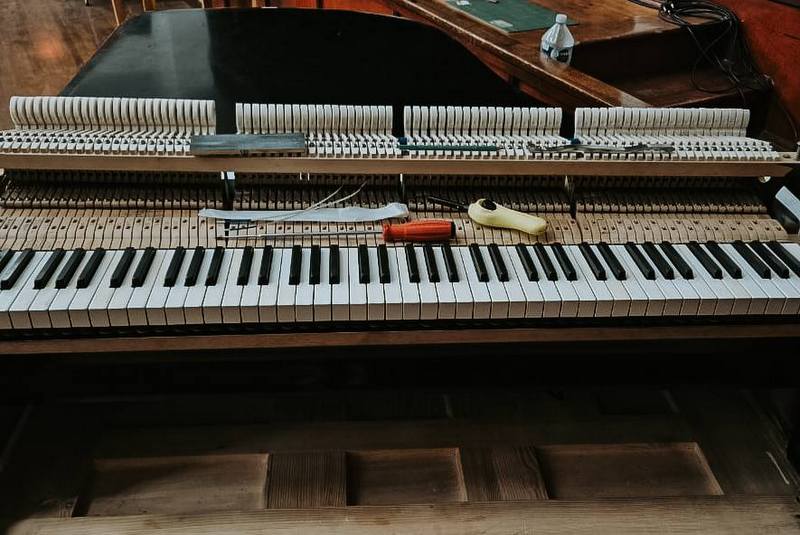Union High School boasts an exceptional musical programme, embodied by its stunning Blüthner Patent Grand Piano, Model 7.
𝘛𝘩𝘪𝘴 𝘦𝘹𝘲𝘶𝘪𝘴𝘪𝘵𝘦 𝘪𝘯𝘴𝘵𝘳𝘶𝘮𝘦𝘯𝘵, 𝘰𝘳𝘪𝘨𝘪𝘯𝘢𝘭𝘭𝘺 𝘤𝘳𝘢𝘧𝘵𝘦𝘥 𝘢𝘳𝘰𝘶𝘯𝘥 1906, 𝘪𝘴 𝘢 𝘵𝘦𝘴𝘵𝘢𝘮𝘦𝘯𝘵 𝘵𝘰 𝘵𝘩𝘦 𝘦𝘹𝘤𝘦𝘱𝘵𝘪𝘰𝘯𝘢𝘭 𝘤𝘳𝘢𝘧𝘵𝘴𝘮𝘢𝘯𝘴𝘩𝘪𝘱 𝘰𝘧 𝘪𝘵𝘴 𝘵𝘪𝘮𝘦 – 𝘸𝘪𝘵𝘩 𝘢 𝘭𝘦𝘯𝘨𝘵𝘩 𝘰𝘧 192𝘤𝘮, 𝘵𝘩𝘦 𝘉𝘭ü𝘵𝘩𝘯𝘦𝘳 𝘔𝘰𝘥𝘦𝘭 7 𝘪𝘴 𝘳𝘦𝘯𝘰𝘸𝘯𝘦𝘥 𝘧𝘰𝘳 𝘪𝘵𝘴 𝘣𝘳𝘪𝘭𝘭𝘪𝘢𝘯𝘵 𝘴𝘰𝘶𝘯𝘥 𝘵𝘩𝘢𝘵 𝘳𝘪𝘷𝘢𝘭𝘴 𝘭𝘢𝘳𝘨𝘦𝘳 𝘱𝘪𝘢𝘯𝘰𝘴, 𝘮𝘢𝘬𝘪𝘯𝘨 𝘪𝘵 𝘢 𝘤𝘩𝘦𝘳𝘪𝘴𝘩𝘦𝘥 𝘢𝘴𝘴𝘦𝘵 𝘧𝘰𝘳 𝘵𝘩𝘦 𝘴𝘤𝘩𝘰𝘰𝘭.
The story of Blüthner pianos begins with Julius Blüthner, who was born in Falkenhain, Germany, in 1824. Initially a cabinet-maker, Blüthner founded his piano-making business in 1853. His dedication and innovation quickly garnered attention; his pianos were showcased at the Industrial Exhibition in 1854 and later adopted by the Leipzig Conservatory. By the turn of the 20th century, Blüthner had become Europe’s second-largest piano manufacturer, producing both grand and upright models that were celebrated worldwide.
𝗜𝗻 𝟮𝟬𝟮𝟰, 𝘁𝗵𝗲 𝘁𝗿𝗲𝗮𝘀𝘂𝗿𝗲𝗱 𝗕𝗹ü𝘁𝗵𝗻𝗲𝗿 𝗴𝗿𝗮𝗻𝗱 𝗽𝗶𝗮𝗻𝗼 𝗮𝘁 𝗨𝗻𝗶𝗼𝗻 𝗛𝗶𝗴𝗵 𝗦𝗰𝗵𝗼𝗼𝗹 𝗿𝗲𝗾𝘂𝗶𝗿𝗲𝗱 𝘂𝗿𝗴𝗲𝗻𝘁 𝗮𝘁𝘁𝗲𝗻𝘁𝗶𝗼𝗻.
Zelda Oosthuizen, the school’s senior music teacher, enlisted the expertise of Mark Davis from Mark Davis Piano Service in Cape Town to restore the instrument’s mechanism. 𝗧𝗵𝗲 𝗿𝗲𝘀𝘁𝗼𝗿𝗮𝘁𝗶𝗼𝗻 𝗽𝗿𝗼𝗰𝗲𝘀𝘀 𝗯𝗲𝗴𝗮𝗻 𝗼𝗻 𝟭𝟰 𝗗𝗲𝗰𝗲𝗺𝗯𝗲𝗿 𝟮𝟬𝟮𝟰, 𝗮𝗻𝗱 𝗰𝗼𝗻𝗰𝗹𝘂𝗱𝗲𝗱 𝗼𝗻 𝟮 𝗝𝗮𝗻𝘂𝗮𝗿𝘆 𝟮𝟬𝟮𝟱, 𝗲𝗻𝗰𝗼𝗺𝗽𝗮𝘀𝘀𝗶𝗻𝗴 𝗮𝗽𝗽𝗿𝗼𝘅𝗶𝗺𝗮𝘁𝗲𝗹𝘆 𝟭𝟱𝟮 𝗵𝗼𝘂𝗿𝘀 𝗼𝗳 𝗺𝗲𝘁𝗶𝗰𝘂𝗹𝗼𝘂𝘀 𝘄𝗼𝗿𝗸.
The restoration focused on revitalizing components that had experienced wear and tear over the decades. Worn cloth, felt and leather were replaced with new materials, including key mortise bushings, backcheck leather, and various felt components.
Additionally, new hammer shanks, flanges and hammerheads were installed, with all center pins replaced to optimize friction and mechanical performance. Each friction point and surface was carefully lubricated, ensuring smooth operation, before the action was reassembled and regulated for optimal performance.
𝘛𝘰 𝘮𝘢𝘪𝘯𝘵𝘢𝘪𝘯 𝘵𝘩𝘦 𝘱𝘪𝘢𝘯𝘰’𝘴 𝘢𝘶𝘵𝘩𝘦𝘯𝘵𝘪𝘤𝘪𝘵𝘺 𝘢𝘯𝘥 𝘲𝘶𝘢𝘭𝘪𝘵𝘺, 𝘢𝘭𝘭 𝘳𝘦𝘱𝘭𝘢𝘤𝘦𝘮𝘦𝘯𝘵 𝘱𝘢𝘳𝘵𝘴 𝘸𝘦𝘳𝘦 𝘴𝘰𝘶𝘳𝘤𝘦𝘥 𝘧𝘳𝘰𝘮 𝘳𝘦𝘱𝘶𝘵𝘢𝘣𝘭𝘦 𝘴𝘶𝘱𝘱𝘭𝘪𝘦𝘳𝘴 𝘴𝘶𝘤𝘩 𝘢𝘴 𝘑𝘢𝘩𝘯 𝘗𝘪𝘢𝘯𝘰 𝘚𝘶𝘱𝘱𝘭𝘺 𝘢𝘯𝘥 𝘈𝘣𝘦𝘭 𝘗𝘪𝘢𝘯𝘰 𝘗𝘢𝘳𝘵𝘴 𝘪𝘯 𝘎𝘦𝘳𝘮𝘢𝘯𝘺. Mark Davis took great care to replace only those materials that had suffered significant deterioration, preserving the unique character of the Blüthner while restoring it to excellent playing condition.
In an additional effort to accommodate the local climate, the piano was pitch-corrected and tuned to A442. This tuning choice considers Graaff-Reinet’s humid summer climate, preventing the pitch from dropping too far during the drier winter months. By tuning to A442 in summer, the piano maintains an optimal pitch range throughout the year, ensuring that its musical integrity remains intact.
𝗧𝗵𝗲 𝗿𝗲𝘀𝘁𝗼𝗿𝗮𝘁𝗶𝗼𝗻 𝗼𝗳 𝘁𝗵𝗲 𝗕𝗹ü𝘁𝗵𝗻𝗲𝗿 𝗣𝗮𝘁𝗲𝗻𝘁 𝗚𝗿𝗮𝗻𝗱 𝗣𝗶𝗮𝗻𝗼 𝗮𝘁 𝗨𝗻𝗶𝗼𝗻 𝘀𝘁𝗮𝗻𝗱𝘀 𝗮𝘀 𝗮 𝗿𝗲𝗺𝗮𝗿𝗸𝗮𝗯𝗹𝗲 𝗳𝗲𝗮𝘁, 𝗰𝗲𝗹𝗲𝗯𝗿𝗮𝘁𝗶𝗻𝗴 𝗯𝗼𝘁𝗵 𝘁𝗵𝗲 𝗶𝗻𝘀𝘁𝗿𝘂𝗺𝗲𝗻𝘁’𝘀 𝗿𝗶𝗰𝗵 𝗵𝗶𝘀𝘁𝗼𝗿𝘆 𝗮𝗻𝗱 𝗶𝘁𝘀 𝗰𝗼𝗻𝘁𝗶𝗻𝘂𝗲𝗱 𝗿𝗼𝗹𝗲 𝗶𝗻 𝗻𝘂𝗿𝘁𝘂𝗿𝗶𝗻𝗴 𝗺𝘂𝘀𝗶𝗰𝗮𝗹 𝘁𝗮𝗹𝗲𝗻𝘁 𝗶𝗻 𝗚𝗿𝗮𝗮𝗳𝗳-𝗥𝗲𝗶𝗻𝗲𝘁.




